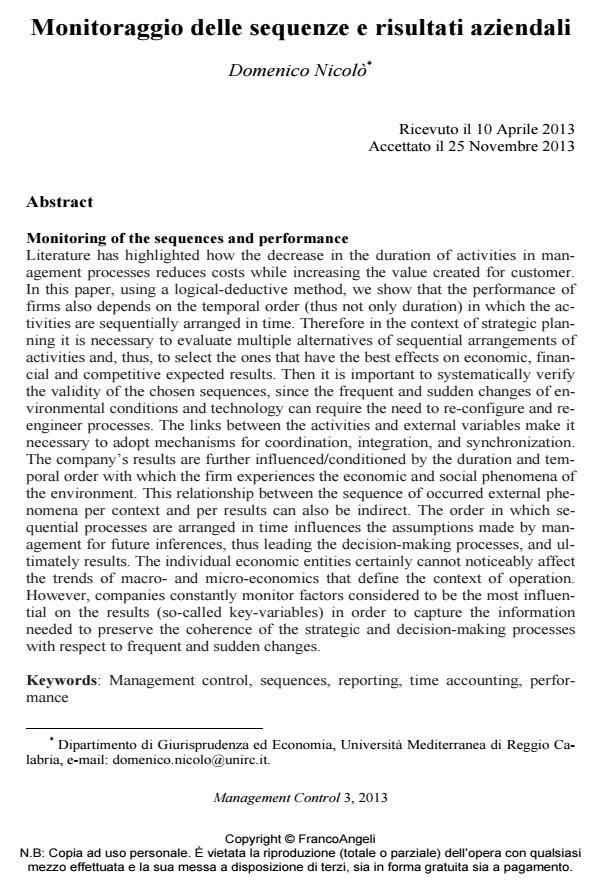Monitoring of the sequences and performance
Journal title MANAGEMENT CONTROL
Author/s Domenico Nicolò
Publishing Year 2014 Issue 2013/3
Language Italian Pages 16 P. 35-50 File size 617 KB
DOI 10.3280/MACO2013-003003
DOI is like a bar code for intellectual property: to have more infomation
click here
Below, you can see the article first page
If you want to buy this article in PDF format, you can do it, following the instructions to buy download credits

FrancoAngeli is member of Publishers International Linking Association, Inc (PILA), a not-for-profit association which run the CrossRef service enabling links to and from online scholarly content.
Literature has highlighted how the decrease in the duration of activities in management processes reduces costs while increasing the value created for customer. In this paper, using a logical-deductive method, we show that the performance of firms also depends on the temporal order (thus not only duration) in which the activities are sequentially arranged in time. Therefore in the context of strategic planning it is necessary to evaluate multiple alternatives of sequential arrangements of activities and, thus, to select the ones that have the best effects on economic, financial and competitive expected results. Then it is important to systematically verify the validity of the chosen sequences, since the frequent and sudden changes of environmental conditions and technology can require the need to re-configure and reengineer processes. The links between the activities and external variables make it necessary to adopt mechanisms for coordination, integration, and synchronization. The company’s results are further influenced/conditioned by the duration and temporal order with which the firm experiences the economic and social phenomena of the environment. This relationship between the sequence of occurred external phenomena per context and per results can also be indirect. The order in which sequential processes are arranged in time influences the assumptions made by management for future inferences, thus leading the decision-making processes, and ultimately results. The individual economic entities certainly cannot noticeably affect the trends of macro- and micro-economics that define the context of operation. However, companies constantly monitor factors considered to be the most influential on the results (so-called key-variables) in order to capture the information needed to preserve the coherence of the strategic and decision-making processes with respect to frequent and sudden changes.
Keywords: Management control, sequences, reporting, time accounting, performance
- Managing uncertainty in the start-up environment. Is a business plan an incentive or a limitation? Giovanna Mariani, Davide Morelli, Leonardo Bartoloni, in MANAGEMENT CONTROL 1/2019 pp.73
DOI: 10.3280/MACO2019-001004 - Il reporting per segmenti nei settori del trasporto pubblico locale e della cura della salute. Esperienze a confronto Domenico Nicolò, Giuseppe Valenza, in MANAGEMENT CONTROL 1/2020 pp.35
DOI: 10.3280/MACO2020-001003
Domenico Nicolò, Monitoraggio delle sequenze e risultati aziendali in "MANAGEMENT CONTROL" 3/2013, pp 35-50, DOI: 10.3280/MACO2013-003003